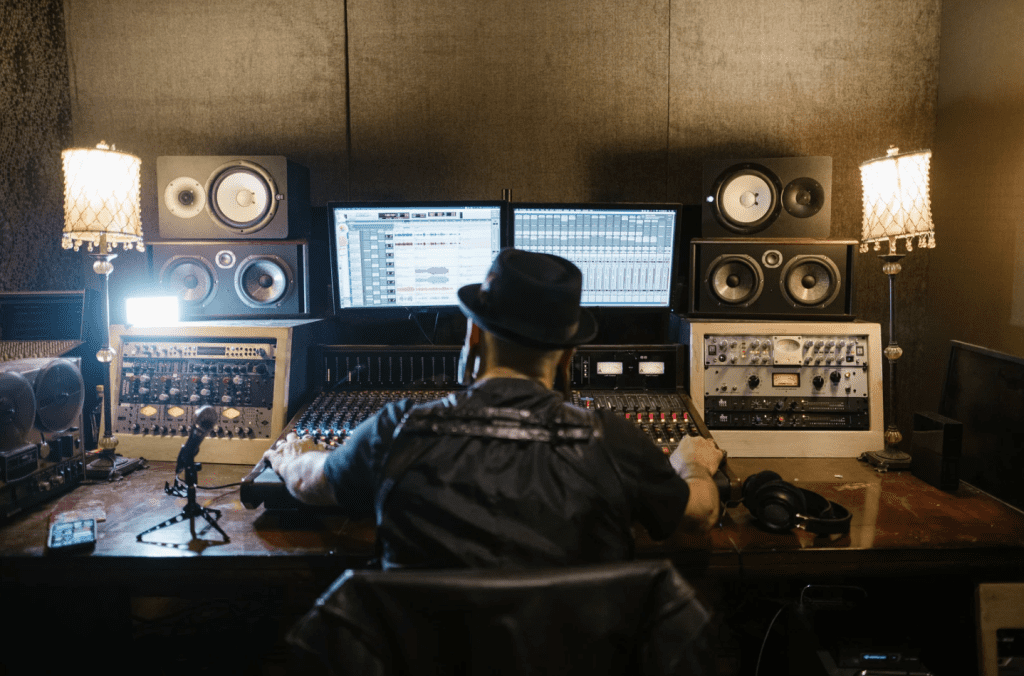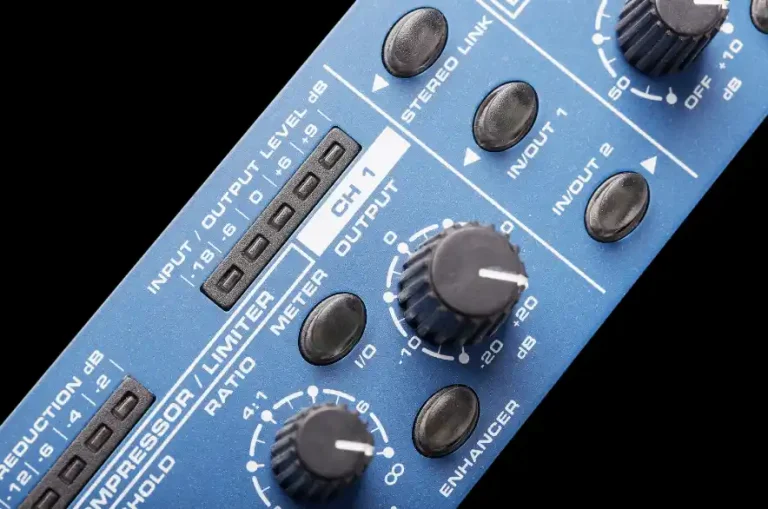How To Use Reference Tracks to Improve Sound Quality In 2023
Are you a music producer or engineer finding it challenging to craft a polished and expert sound for your music?
Are you looking to improve the sound quality of your tracks and achieve a level of excellence similar to commercially thriving tracks in your music genre?
Then, it’s time to start mixing and introducing reference tracks into your music production workflow.
This article will delve into the significance of references when making music and how to carefully select and utilize them to enrich the quality of your music.
If you’re eager to elevate your music game, read on!
Key Takeaways
What are reference tracks?

Reference tracks, or mix references, are essential for any producer or engineer looking to achieve a professional sound.
These tracks are carefully selected songs representing a particular style or genre and are used as a benchmark for comparison during mixing and mastering.
By comparing their mix to a reference track, a producer can identify issues with their track’s balance, EQ, dynamics, and overall sound quality.
This allows them to make necessary adjustments and create a finished product that sounds as good as commercially successful tracks in the same genre.
Are Reference Tracks Important?
Reference tracks are essential for creating professional-sounding music in a “mix session.”
With this method, you can compare your own mix with commercially successful songs regarding all the instruments, mix level tonal balance, dynamics, and stereo imaging.
This comparison can help you identify areas for improvement and make necessary adjustments to your own favorite songs.
Without it, it can be challenging to create a high-quality mix, and your music may lack the polish and professionalism that sets it apart from amateur productions.
Therefore, incorporating references in your production process is crucial to producing your best work.
Benefits of reference tracks
Reference tracks can also be valuable for mix engineers during the mixing phase.
By referencing well-mixed songs in the same genre, they can understand how the full frequency range and spectrum are balanced in those songs and how to achieve a similar balance in their own mixes.
This can help them to identify any frequency imbalances or issues in their mix and make the necessary adjustments to create a more cohesive and professional sound.
It can lead to more efficient and effective mixing, producing a high-quality final product.
How to choose reference tracks
Choosing reference tracks can be daunting, especially for new producers and engineers.
However, it’s a crucial step in the production process.
They are the benchmark you will use to measure the quality of your mix or master.
Tips for finding the Perfect Reference Track
Finding the perfect reference is crucial to achieving a high-quality mix or master, but it can be challenging to know where to start.
Here are some tips to help you find the perfect reference track for your project:
- Identify your goal: Ask yourself what you want to achieve with your mix or master. This will help you determine the specific characteristics you’re looking for. For example, if you want a punchy and tight low end, look for a mix reference that has a similar sound.
- Listen to various tracks: Before making a final decision, listen to several reference tracks. This will give you a better understanding of what works and doesn’t work for your project. Be bold and use reference music from different genres. Sometimes, the best reference can come from unexpected sources.
- Use professionally mixed and mastered tracks: To ensure you compare your work to the highest standard possible, use references that have been professionally mixed and mastered. This will give you a better idea of what a finished, polished track should sound like.
When choosing a reference track for audio mixing, one important consideration is the genre of music.
Different genres have distinct audio characteristics that should be considered when selecting a reference track.
For example, a reference track in the rock genre may have a more prominent guitar sound, while a reference track in the EDM genre may feature heavy use of electronic instruments and effects.
For example, if the mixed song features a powerful lead vocal, choosing a reference track showcasing a similar vocal style and tone is essential.
In summary, finding the perfect reference track is essential in the production process.
By identifying your goals, listening to various tracks, and using professionally mixed and mastered tracks, you can find the perfect track to help you achieve your desired sound.
How to Use Reference Tracks
Here are some steps on how to use reference tracks effectively:
- Choose a reference track that is similar to the style of music you are producing. Make sure it is a high-quality recording.
- Listen to the track in detail and note all the elements that stand out to you, such as the arrangement, mixing, and mastering techniques.
- Analyze the frequency spectrum of the music using a spectrum analyzer. This will give you an idea of the frequency balance and dynamics of the track.
- Compare your mix to your chosen reference, and adjust your mix as necessary. This might involve adjusting EQ, compression, reverb, or other effects to make your mix sound more like the track you refer to.
- Take regular breaks from listening to the reference music so that you can return to it with fresh ears.
- Keep your reference music in mind throughout the entire mixing and mastering process. Use it as a benchmark for the quality of your own track.
Overall, reference tracks are an effective way to improve the quality of your own music.
By comparing your tracks to a high-quality reference, you can identify improvement areas and adjust accordingly.
Reference in Every Stage of Music Production
Music producers and engineers highly recommend using reference music in every production stage.
It helps maintain a consistent quality level, especially when working on large projects that may take weeks or months to complete.
Here are some ways to use it in different stages of music production:
Pre-production:
During pre-production, it can help define the project’s direction.
It can be a starting point for the project’s mood, tempo, and instrumentation.
Listening to a hit record or just a song that shares similarities with the project make envisioning the song and its outcome easier.
Tracking:
During tracking, reference can determine the tonal balance and placement of instruments in the mix.
By referencing a well-mixed track, the tracking and mixing engineer can balance the level and tone of each instrument, allowing for more clarity and better blending of sounds during mixing.
Mixing:
Reference tracks can help achieve a balanced and cohesive mix during mixing.
Comparing the project makes identifying the problem areas in the mix easier.
The mixing engineer can then use them to set levels, EQ, and apply other processing to the project, to make it sound more like the reference track.
Mastering:
During mastering, they can help to achieve a consistent overall volume and frequency balance.
By comparing the mastered track, the mastering engineer can set the final volume levels and apply processing to achieve a similar volume and frequency balance to the reference stereo track.
In conclusion, using reference tracks throughout the sound production process is a useful technique to improve the quality of the final product.
It helps to maintain consistency in the sound quality and balances the tonal and frequency elements of the music.
It is essential to select high-quality references that share similarities with your project to achieve a desirable outcome.
Using Audio Reference Tracks When Producing Music
In addition to helping with mixing decisions, reference tracks can also be a valuable tool in the production stage of music creation.

Here are some of the ways using audio reference tracks during production can help you improve your music:
Provide inspiration and guidance: Reference tracks can show you how to structure your own music, choose the right instruments and sounds, and create compelling arrangements.
Help you learn and improve: Analyzing reference tracks with a similar sound to what you want to create can increase your knowledge.
Identify improvement areas: Comparing your work to professionally produced reference tracks can help highlight weaknesses in your mix, arrangement, and overall sound.
Stay motivated and inspired: Listening to successful tracks in your genre helps you keep up with trends and techniques and remain creative.
Composition: Reference tracks can also be used in the composition. Producers or artists can study chord progressions, arrangements, and other ideas from a reference track before creating their songs.
Modern digital audio workstations (DAWs) have made accessing and using a reference track in production even easier. Here is why:
- Digital Audio Workstations (DAWs) simplify importing reference tracks and instantly comparing them to your work.
- With the A/B comparison feature, you can quickly switch between your mix and the reference track to identify differences that need improvement.
- Certain DAWs include automatic tempo and pitch-matching tools to create music in a specific genre or style.
- Visualization tools are also included in DAWs, allowing users to visualize frequencies, levels, etc. – making it much easier to benchmark against reference tracks and determine what adjustments need to be made.
When picking out reference tracks for production, make sure they showcase the production technique or sound you wish to replicate in your music.
Incorporating the best reference tracks into the music creation will give you advantages as a producer.
Reference Tracks in Hip Hop Music Production
Hip-hop music is known for its signature sound that consists of prominent bass guitar lines and drum machine beats.
Using a reference track can help producers and artists understand how to incorporate these elements into their work.
In the studio, reference tracks guide the mixing and mastering process.
By comparing the reference track with the mix of the new song, producers and engineers can adjust EQ, compression, and other effects to get a similar sound.
What Is The Difference Between Using Mixing & Mastering References?
Mixing and mastering are two distinct stages of music production.
The first, mixing, involves blending together different tracks – such as vocals, instruments, and effects – to create a unified and cohesive sound.
Mastering follows this, dealing with the overall sound by making adjustments like equalization (EQ), compression, and limiting before the final mix is ready for distribution.
Mixing References:
- Used during the mixing process to compare the individual elements of your mix to a professionally mixed track.
- Helps you to achieve a balanced and cohesive sound by providing a reference point for how different elements in the mix should sound and interact with each other.
- Typically involves referencing a professionally mixed and mastered track with a style or genre similar to your mix.
Mastering References:
- Used during the mastering process to compare the overall sound of your mix to a professionally mastered track.
- Helps you to ensure that the overall sound of your mix is competitive with other professionally mastered tracks in the same genre.
- Typically, referencing a professionally mastered track with a style or genre similar to your mix.
- Helps you to make adjustments to the overall sound of your mix, including EQ, compression, and limiting, to prepare it for distribution.
Conclusion
To attain a professional sound, reference tracks are an indispensable tool for any producer or engineer.
Comparing the mix and the reference track can reveal disparities in the track’s equilibrium, tonal balance, dynamics, and overall sound quality.
Reference tracks improve the mixing process, making it more efficient and effective and improving how your own productions, songs, productions, and mixes sound.
Selecting the ideal reference track is crucial and involves determining the end goal, evaluating various tracks, and employing professionally mastered and mixed tracks.
It’s imperative to incorporate reference music in all stages of the production process, from pre-production to tracking, mixing, and mastering, to ensure consistent sound quality and reach the intended outcome.
Sources
https://producelikeapro.com/blog/reference-tracks/
https://www.izotope.com/en/learn/13-tips-for-using-references-while-mixing.html







